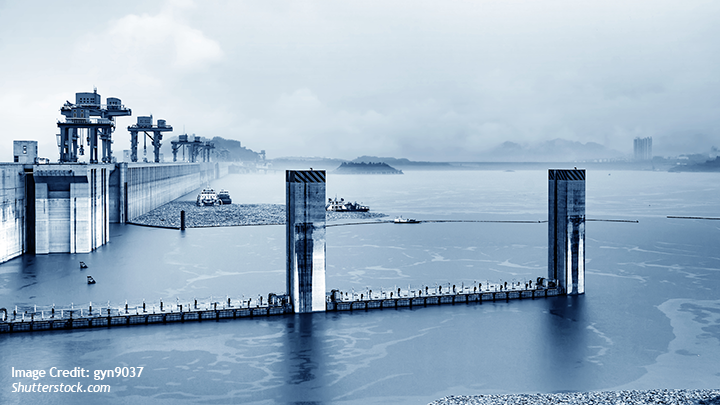Cascading Effects: Will China’s New Dam Create A Himalayan Rift?

Jagannath Panda and Mrittika Guha Sarkar
In mid-December, China marked the thirtieth anniversary of the official inauguration of the Three Gorges Dam on the Yangtze River, the world’s largest hydroelectric project (in terms of installed capacity). Notwithstanding the decades-long ecological controversies surrounding the dam, the Chinese government has boosted the project as a hallmark of its economic development policies.
Days after the anniversary, Chinese state media announced that the government had approved another massive hydropower project in the lower reaches of the world’s highest river, Yarlung Zangbo (or “Yarlung Tsangpo,” the Tibetan name for the river also known as the Brahmaputra in India, which becomes the Jamuna River once it enters Bangladesh). Reports of a new mega-dam are not new. In 2020, state media crowed about building a “historic” hydroelectric project in Tibet. However, speculation about China damming the Yarlung Tsangpo-Brahmaputra at the remote “Great Bend” of the river swirled long before President Xi Jinping came to power.
Unfortunately, China’s push for mega dams has become a routine headline-grabber, showcasing the country’s engineering capabilities and renewable energy ambitions. Alongside these mega-dams, China has also invested heavily in Small Hydropower Projects (SHP). These smaller-scale developments have helped to position China as a model for developing countries, offering sustainable and decentralized energy solutions, particularly in rural and remote areas. While SHPs have played a significant role in addressing domestic energy challenges, they complement rather than replace the broader strategy of large-scale hydropower development.
However, the continued protests in Tibet against China’s over-damming of rivers that originate in the Tibetan glaciers, as well as protests from downstream countries like India and Bangladesh, have put the spotlight on China’s true aims. China’s unilateral pursuit of hydroelectric and water resources in transnational rivers belie its claims to be acting solely in the interests of “economic development” and “climate neutrality.”
The Numbers Game
The proposed Medog Hydropower Station in Tibet represents a monumental leap in China’s ambition to harness its water resources. However, the details surrounding the project remain largely opaque. The available information showcases China’s political intent and technological prowess as well as the complex costs and challenges inherent in such a massive undertaking.
The project’s scale is unparalleled. Expected to generate over 300 billion kilowatt-hours of electricity annually—more than triple the capacity of the Three Gorges Dam—the project is projected to cost upwards of $137 billion, dwarfing the Three Gorges’ $34 billion price tag. These figures underscore China’s determination to assert itself as a leader in renewable energy infrastructure. Yet, they also raise questions about the broader implications of such a colossal endeavor.
The dam is situated in the Indo-Tsangpo Suture Zone, a seismically active region of the Himalayas where the Indian and Eurasian tectonic plates converge. This location presents significant structural resilience challenges. The 2011 Sikkim earthquake near the Indian border serves as a stark reminder of the vulnerability of Himalayan hydropower projects to tectonic stresses. Furthermore, the project’s construction runs the risk of exacerbating geological instability, triggering landslides or earthquakes with potentially catastrophic consequences for local communities and downstream ecosystems. The Medog project, located in one of the rainiest parts of mainland China, further amplifies these risks due to its reliance on unpredictable hydrological and geological conditions.
China’s earlier hydropower projects, such as the Three Gorges Dam, have demonstrated the unintended consequences of large-scale sediment disruption, including reduced agricultural productivity and diminished biodiversity downstream. The Yarlung Zangbo River, the lifeblood of many ecosystems in South Asia, could face similar degradation, affecting not just local environments but also neighboring countries dependent on its waters.
Socially, the project’s human impact is equally troubling. Medog County, with a population of around 14,000, may see fewer displacements compared to the 1.4 million uprooted by the Three Gorges Dam, but even limited relocation carries profound consequences. The loss of livelihoods, cultural heritage, and social cohesion can marginalize affected communities, creating long-term challenges.
Inflaming The Tibetan Ecosystem
China’s continued push for dams on Tibetan rivers is a direct result of its growing demands for not only water for drinking and other purposes but also electricity amid shrinking resources. This latter demand, in turn, is in large part compounded by China’s expanding infrastructure activities in Tibet, mainland China, and in the border areas.
Undoubtedly, the over-damming will weaken the Tibetan Plateau’s ecosystem, which is already under strain due to global warming. The Tibetan Plateau, often referred to as the “Third Pole,” is warming at a rate nearly two times the global average. This accelerated warming is melting glaciers rapidly, destabilizing seasonal river flows, and increasing sedimentation risks in dam reservoirs. Additionally, aerosol deposits in the region further amplify glacial retreat, compounding risks for downstream populations and ecosystems. These cascading climate risks not only endanger ecosystems but also exacerbate security concerns.
Water scarcity driven by glacial retreat could heighten cross-border tensions over resource access, particularly between India and China, where disputes over water-sharing remain unresolved. The infrastructure activities by China are bound to increase environmental disasters such as flash floods and earthquakes. For example, after the floods in 2020 that strained China’s dams and crippled domestic woes, debates over whether such dams, including the Three Gorges Dam, were truly necessary to get a new lease.
However, China has insisted on whitewashing the concerns around its over-exploitation of Tibetan resources as efforts that are contributing to climate action, primarily as projects that will usher in cleaner, green energy and reduce China’s dependence on coal-fired thermal power plants. China claims that the latest project will allow it to achieve its stated objectives of reaching a carbon emissions peak before 2030 and carbon neutrality by 2060.
Notably, even as the state media and officials have insisted that such hydropower constructions have mitigated the possibilities of higher losses and are built to withstand immense pressures, critics have correctly emphasized the limits of human control. They argue that hydropower projects like the Medog Dam undermine sustainable development. Case studies from the Lancang-Mekong River reveal that large dams reduce sediment flow by over 50 percent, leading to biodiversity collapse and fish population declines. This mirrors the risks facing the Yarlung Tsangpo Basin, as unchecked damming could destabilize critical ecosystems.
Strategic Implications For Himalayan States In South Asia
Not just the Tibetans but Himalayan states as a whole will bear the brunt of China’s goals. In response to China’s aforementioned infrastructure (damming) activities in the vicinity of the Indian state of Arunachal Pradesh, India submitted its concerns to Beijing: “The Chinese side has been urged to ensure that the interests of downstream states of the Brahmaputra are not harmed by activities in upstream areas.”
More to the point, India has already initiated plans to build dams on the tributaries of Brahmaputra. These hydropower projects are part of India’s broader strategy to counterbalance China’s dam-building spree. However, without regional coordination, such efforts risk compounding ecological harm in the fragile region. Additionally, China’s Belt and Road Initiative (BRI) extends its geopolitical influence across South Asia, leveraging massive infrastructure projects to strengthen economic ties with Bangladesh, Nepal, Pakistan, and Bhutan.
As per Indian media reports, the Indian government has initiated the development of thirteen hydropower projects in Arunachal Pradesh, with an investment of INR 1.4 lakh crore (~$16 billion). In August 2023, it signed a memorandum of agreement with NEEPCO, SJVN, and NHPC to execute these stalled projects, totaling a capacity of 11.2 GW. This strategic push reflects India’s assertive stance on harnessing its hydropower potential. However, success depends on addressing environmental concerns and local opposition, as well as ensuring transparency.
Already, the 2020 Galwan clash and China’s ongoing strategy of claiming territories in the Himalayas (e.g., the new standard map in 2023 and the China-Nepal boundary row in Humla in 2020) have almost permanently heightened tensions along China’s borders, the intermittent thaws notwithstanding. Another layer was added to the India-China long-standing mistrust when China—in the same month as the announcement of the Medog Dam—created two new counties, one of which is contested by India since it falls within India’s Union Territory of Ladakh.
Notably, China is challenging the “trans-Himalayan balance of power” via its infrastructure projects as well as financial and political clout in South Asia, primarily Bangladesh, Nepal, and Pakistan. This trans-Himalayan contest extends beyond traditional territorial disputes, as water security is increasingly intertwined with broader geopolitical rivalries. The Medog Dam grants China significant upstream control over the Brahmaputra, raising fears of strategic weaponization of water during conflicts. Such control could enable China to influence downstream water availability, particularly during the dry season, potentially crippling agriculture and hydroelectric output in India and Bangladesh.
The good news is that the recently concluded special representatives meeting has provided momentum for further strategic dialogue between India and China, including the sharing of data on transboundary rivers. Yet China’s announcement about building a contested dam on the Brahmaputra will give rise to new misgivings on the bilateral front. Beyond bilateral concerns, the Medog Dam underscores China’s evolving “hydro-hegemony,” where control over shared water resources becomes a strategic tool for regional influence. This is reminiscent of China’s activities along the Mekong River, where damming has curtailed flow to downstream nations, amplifying droughts and increasing dependency on Beijing for water management solutions.
In South Asia, India’s response has been largely reactive and has been characterized by stalled or delayed dam projects in Arunachal Pradesh. This reflects a lack of cohesive strategy in dealing with China’s upstream dominance. The failure of past deals to share adequate water data (e.g., China’s refusal to cooperate during the Doklam standoff) and the apparent lack of willingness on China’s part to foster consensus continue to exacerbate existing challenges.
Catalyzing Targeted Strategies
Building on the analysis of China’s hydro-hegemony and its cascading impacts, fostering regional stability and sustainable development requires targeted strategies that address both geopolitical tensions and environmental concerns. While the realities of South Asian geopolitics make sweeping agreements challenging, incremental steps rooted in collaboration and pragmatism offer a way forward. The absence of robust transboundary water-sharing agreements exacerbates mistrust among nations.
Expanding existing bilateral mechanisms into a formal transboundary water-sharing framework remains essential. While a Mekong River Commission-style agreement may be ambitious, incremental steps like joint hydrological monitoring and sediment data-sharing could build trust and provide a foundation for future negotiations. At the same time, South Asia must diversify its energy strategy. Collaborative solar and wind energy projects along India-Nepal or India-Bangladesh borders can alleviate energy pressures while reducing reliance on ecologically damaging hydropower. These initiatives could also dilute China’s infrastructural dominance in the region.
Finally, a participatory approach to infrastructure planning is vital. Including local and indigenous voices in development decisions, as seen in India’s sovereign state in Sikkim’s smaller hydropower projects, could help balance ecological preservation with energy needs. The hope remains that the stakeholder countries will place ecological and regional stability above their domestic agendas.
This piece was first published in The National Interest (Washington DC) on February 15, 2025.
Related Publications
-
Repurposing the United Nations to Address the Climate Crisis on the Tibetan Plateau
The futures of people along China’s western frontier changed dramatically with the annexation of Xinjiang in 1949 and Tibet in 1950. When Communist China emerged from decades of isolation in […]
-
Going for Gold on the Tibetan Frontier
In 2025, China is hungrier than ever for gold, as an abiding holder of accumulated wealth, in a time when even the biggest Chinese real estate builders, tech entrepreneurs, exam […]
-
COP30: Time for Action on the Himalayan Region
The Himalayas have faced unprecedented ecological, weather-related, and geotectonic disasters, exacerbated by human activity, disrupting ecosystems and local livelihoods. Despite these pressing issues, international climate discussions, particularly at COP29, largely […]
-
PRC Mining in Tibet – a European Perspective
Given the enormous geostrategic and environmental importance of the Tibetan Plateau, what the People’s Republic of China (PRC) does with Tibet’s waters and its minerals does not concern the PRC […]
-
Report of the Webinar on Dam Construction & Tibet as a Hydropower Zone: Implications on Tibet’s Climate Crisis? (Climate Crisis in Tibet-II)
This webinar, organized by the SCSA-IPA at the Institute for Security and Development Policy (ISDP), was held on January 20, 2025. It is the second in a series on the […]




